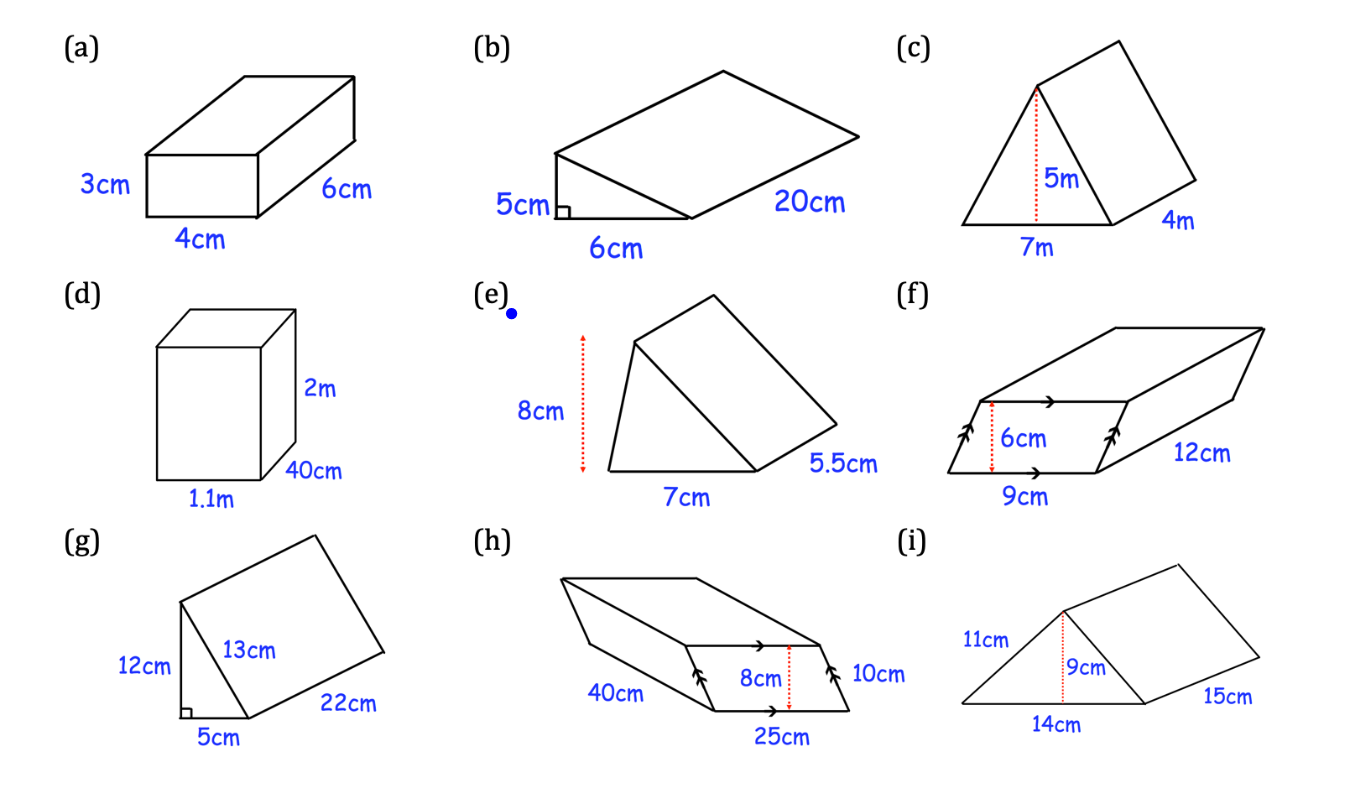Calculate the volume of the shapes in the image.

Understand the Problem
The question likely requires calculating the volume or surface area of various 3D geometric shapes, given their dimensions. Each shape is labeled (a) through (i), and the task is to apply the appropriate formulas to find the volume or surface area. To fully understand what the user wants, it helps to understand the question.
Answer
(a) $72 \text{ cm}^3$ (b) $300 \text{ cm}^3$ (c) $70 \text{ m}^3$ (d) $0.88 \text{ m}^3$ (e) $154 \text{ cm}^3$ (f) $648 \text{ cm}^3$ (g) $660 \text{ cm}^3$ (h) $2600 \text{ cm}^3$ (i) $693 \text{ cm}^3$
Answer for screen readers
(a) $72 \text{ cm}^3$ (b) $300 \text{ cm}^3$ (c) $70 \text{ m}^3$ (d) $0.88 \text{ m}^3$ (e) $154 \text{ cm}^3$ (f) $648 \text{ cm}^3$ (g) $660 \text{ cm}^3$ (h) $2600 \text{ cm}^3$ (i) $693 \text{ cm}^3$
Steps to Solve
Okay, let's break down how to find the volume of each of these shapes. We will use appropriate volume formulas for each shape.
- (a) Rectangular Prism Volume
The volume $V$ of a rectangular prism is given by $V = l \times w \times h$, where $l$ is the length, $w$ is the width, and $h$ is the height. In this case, $l = 6$ cm, $w = 4$ cm, and $h = 3$ cm. So, $V = 6 \times 4 \times 3 = 72$ cubic centimeters.
- (b) Triangular Prism Volume
The volume $V$ of a triangular prism is given by $V = A \times h$, where $A$ is the area of the triangular base, and $h$ is the height (or length) of the prism. The area of the triangle is $ A = \frac{1}{2} \times b \times h_t$, where $b$ is the base of the triangle, and $h_t$ is the height of the triangle. Here, $b = 6$ cm, $h_t = 5$ cm, and $h = 20$ cm. So, $A = \frac{1}{2} \times 6 \times 5 = 15$ square cm. Then, $V = 15 \times 20 = 300$ cubic centimeters.
- (c) Triangular Prism Volume
Same as (b). Here, $b = 7$ m, $h_t = 5$ m, and $h = 4$ m. So, $A = \frac{1}{2} \times 7 \times 5 = 17.5$ square meters. Then, $V = 17.5 \times 4 = 70$ cubic meters.
- (d) Rectangular Prism Volume
The volume $V$ of a rectangular prism is given by $V = l \times w \times h$. First, we need to convert all measurements to the same unit. Let's convert everything to meters. $l = 1.1$ m, $w = 40$ cm $= 0.4$ m, and $h = 2$ m. So, $V = 1.1 \times 0.4 \times 2 = 0.88$ cubic meters.
- (e) Triangular Prism Volume
Same as (b). Here, $b = 7$ cm, $h_t = 8$ cm, and $h = 5.5$ cm. So, $A = \frac{1}{2} \times 7 \times 8 = 28$ square cm. Then, $V = 28 \times 5.5 = 154$ cubic centimeters.
- (f) Parallelepiped Volume
The volume $V$ of a parallelepiped is given by $V = A \times h$, where $A$ is the area of the base, and $h$ is the height of the prism. The area of the parallelogram is $ A = b \times h_p$, where $b$ is the base of the parallelogram, and $h_p$ is the height of the parallelogram. Here, $b = 9$ cm, $h_p = 6$ cm, and $h = 12$ cm. So, $A = 9 \times 6 = 54$ square cm. Then, $V = 54 \times 12 = 648$ cubic centimeters.
- (g) Triangular Prism Volume
Same as (b). Here, $b = 5$ cm, $h_t = 12$ cm, and $h = 22$ cm. So, $A = \frac{1}{2} \times 5 \times 12 = 30$ square cm. Then, $V = 30 \times 22 = 660$ cubic centimeters.
- (h) Trapezoidal Prism Volume
The volume $V$ of a trapezoidal prism is given by $V = A \times h$, where $A$ is the area of the trapezoidal base, and $h$ is the height (or length) of the prism. The area of the trapezoid is $A = \frac{1}{2} \times (b_1 + b_2) \times h_t$ where $b_1$ and $b_2$ are the lengths of the parallel sides, and $h_t$ is the height of the trapezoid. Here, $b_1 = 25$ cm, $b_2 = 40$ cm, $h_t = 8$ cm, and $h = 10$ cm. So, $A = \frac{1}{2} \times (25 + 40) \times 8 = \frac{1}{2} \times 65 \times 8 = 260$ square cm. Then, $V = 260 \times 10 = 2600$ cubic centimeters.
- (i) Triangular Prism Volume
Same as (b). Here, $b = 14$ cm, $h_t = 9$ cm, and $h = 15$ cm. So, $A = \frac{1}{2} \times 14 \times 9 = 63$ square cm. Then, $V = 63 \times 11 = 693$ cubic centimeters.
(a) $72 \text{ cm}^3$ (b) $300 \text{ cm}^3$ (c) $70 \text{ m}^3$ (d) $0.88 \text{ m}^3$ (e) $154 \text{ cm}^3$ (f) $648 \text{ cm}^3$ (g) $660 \text{ cm}^3$ (h) $2600 \text{ cm}^3$ (i) $693 \text{ cm}^3$
More Information
Here's a brief recap of what each answer represents:
- (a) Volume of a rectangular prism.
- (b) Volume of a triangular prism.
- (c) Volume of a triangular prism.
- (d) Volume of a rectangular prism.
- (e) Volume of a triangular prism.
- (f) Volume of a parallelepiped.
- (g) Volume of a triangular prism.
- (h) Volume of a trapezoidal prism.
- (i) Volume of a triangular prism.
Tips
A common mistake in these types of problems is forgetting to ensure all measurements are in the same units before calculating the volume, as seen in part (d). Forgetting the $1/2$ factor when calculating the area of a triangle is also a common mistake. Also, incorrectly identifying the base and height.
AI-generated content may contain errors. Please verify critical information